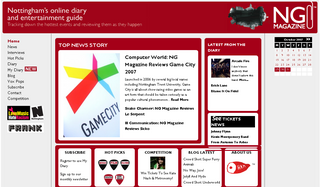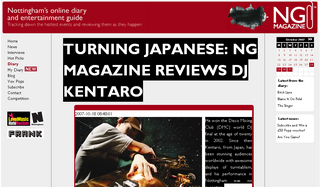skip to main |
skip to sidebar
View the original at NG Magazine
Launched in 2006 by several big local names including Nottingham Trent University, Game City is all about showcasing video games as an art form that should be taken seriously as a popular cultural phenomenon.

The event was hosted prominently at Market square, where for the duration a huge screen flashed up information about new Nintendo Wii games, including Lego Star-Wars. However, Game City events were also held at The Broadway Cinema and many other Nottingham locations. The programme included clinics for aspiring designers, information for those looking for a step onto the gaming careers-ladder, as well as many keynote speeches (introductory talks) about new games and other such cyber-stuff.
Completely independent from the games industry, the event (unlike other media showcases) never feels like an excuse for games manufacturers to push their advertising upon you. The result is that people aren't scared away, and are able to walk away without piles of glossy flyers stuffed in their pockets. Many of the people I spoke to at Game City weren’t nerdy games enthusiasts, but had just come along to have a look at what was going on, exactly as the organisers had intended.
Sarah Mallick and Rosie McCrossan were two such people. They said: “We came to Game City because we wanted to try the Wii. We've never played before but thought it was really good." Sarah added: "Wii-tennis was good fun, even though I'm rubbish at normal tennis.”
When asked about the organisation of the event, the two seem pretty satisfied: "The stewards are really good at making sure everyone gets to try the games and stopping the kids from hogging them."
Other games on show were Guitar Hero as well as the newly released Halo 3. Possibly the most anticipated product was the new Lego Star-Wars game, which enables gamers to wield their Wii remotes as light-sabres. Demoed on the big screen by a Nintendo representative, this was big news for the gaming community and Star-Wars geeks alike.
Consoles didn't take all the limelight however, as PC games had as much exhibition and interest, but seemed to be geared more towards the hardcore gaming fanatic. There's something about sitting at a desk with a keyboard and mouse that makes PC gamers seem more dedicated and thus geekier than their console-playing counterparts.
Game City managed to generate massive interest in the centre of Nottingham. Despite being held during the half-term holidays, it wasn't beset with children or teenagers. The stewards were all friendly and made sure everyone was able to sample the range of digital-delights available. For the more serious gamer there were plenty of careers advice, designer workshops and industry announcements.
These latter events were ticketed, but if you just wanted to drop into Market Square and try some of the new games and consoles then you were able to do so completely free of charge. For an event that is only its second year, Game City had loads to offer. It’s set to return in 2008 and you should expect it to be much, much bigger.
Game Boy: Alex Ward
See the original at NG-Magazine
Directed by Corneliu Porumboiu, the title for 12:08 East of Bucharest as it was released in Romania is: "A revolution, or not a revolution." That is, in an essence, what the film is about. Set in a small town, a textile engineer-come-journalist hosts a Christmas talk show to determine whether or not a revolution occurred in the small town 19 years previously, when their country broke free from dictatorship. Was it a revolution, or a tall-story made up by a group of drunks?

The film reeks of typical post-communism depression. It is almost clichéd, though is spared by the stylish way it is filmed. Shots of characterless, bleak Romanian suburban sprawls are frequent and make the viewer feel as lethargic as the eastern European characters do themselves. It's not until the latter half that we are able to relax, and really get our teeth into the plot.
This is because the film is shot in a highly voyeuristic manner. They are mostly taken from a stationary camera that captures events within one room at a time. This gives the impression that you're a peeping tom looking around corners, though some scenes are framed as if the camera has been placed upon a bookshelf and forgotten about. The effect is that the audience is thrown into the lives of the three main characters.
The second part of the film is set in the TV studio, through the lens of the cameras filming the chat show. This is where the atmosphere of the entire production is lifted and elements of comedy replace the dreary monotony of the former part. The shambolic production of the chat show which broadcasts on a shoestring, and to only a handful of people, is highly amusing. Yet through the performances of the three main characters the importance of the inquest is clear. Such realistic and refined acting is hard to find and is highly evident here. One wonders whether they were even given scripts or simply told to improvise. The atmosphere created by the actors, particularly Ian Sapdaru who plays Manescu the drunken teacher, affects the sympathies of the audience greatly.
As a display of cinematic artistic prowess, or of acting brilliance, 12:08 East of Bucharest is fantastic. After all it has won nine awards and has been nominated for a further three. However, the film lacks a degree of aesthetics. It is by no means a comfortable view, and although there are elements of comedy, the audience is never left to fall in love with the characters, despite the great skill they are portrayed with. Like the great painting the Mona Lisa, one can appreciate its artistic brilliance, but probably wouldn't ever hang it on their wall.
See the original at NG-Magazine.com
He won the Disco Mixing Club (DMC) world DJ final at the age of twenty in 2002. Since then Kentaro, from Japan, has been stunning audiences worldwide with awesome displays of turntablism, and his performance in Nottingham was no exception.

As a turntablist, Kentaro doesn't merely play records; he manipulates the sounds of his vinyl, playing the decks like an actual instrument. This has been said about many other DJs before but none more accurately than Kentaro. If you have no idea what I mean then have a look for him on You-Tube.
Stealth, on Nottingham's Goldsmith St, was packed full of people willing to pay the £10 entrance fee to see Kentaro, amongst many other artists. The downstairs room was extremely busy but compared to some of Kentaro's other ventures, Friday was a pretty intimate gig: Cameras and projector screens were set up in order to make the DJ's work more visible, but most people had direct views anyway.
Kentaro's performances are as much about seeing what he's doing as hearing it. Scratching with crossed arms, spinning around and flipping the cross fader through his legs is such an example of the flair that goes into one of his shows. He is very much a performer and stimulates shouts from the crowds with his style.
Kentaro played for almost two hours, all the time scratching and mixing. The stacks of vinyl that were piling up next to him kept falling over, but even as he picked these up it had no effect on his show. He is the kind of artist who knows his instrument intimately, meaning that whatever may happen he is able to improvise.
Kentaro is on his world tour, his last British date was in Manchester on Saturday 13 October. Fans at the Nottingham gig told me he tours every four years, so your next chance to see him in Britain may be in 2011. Hopefully it'll be much sooner.



